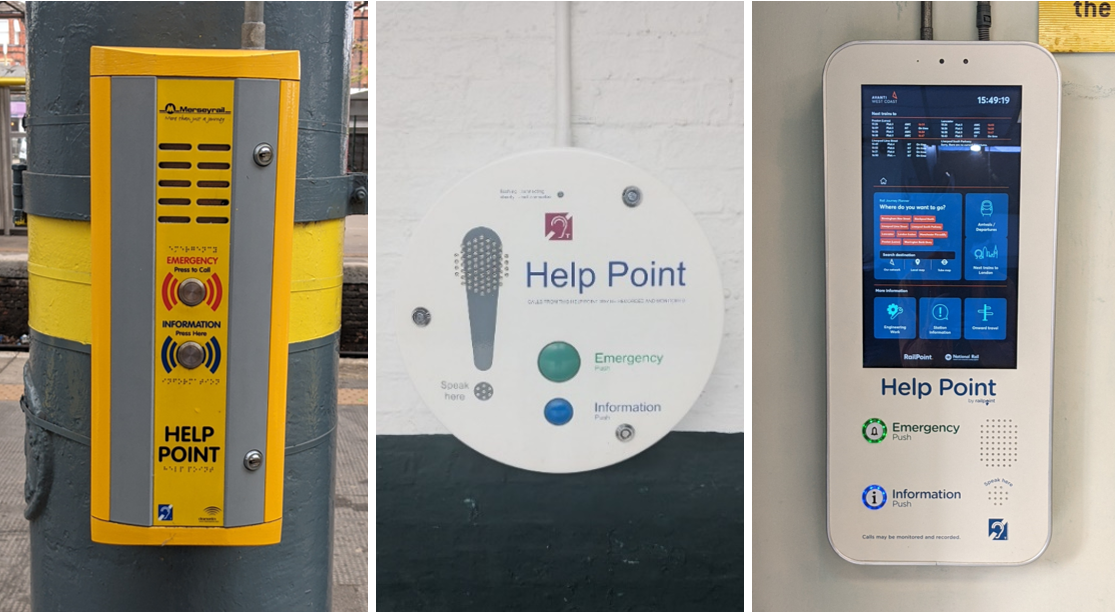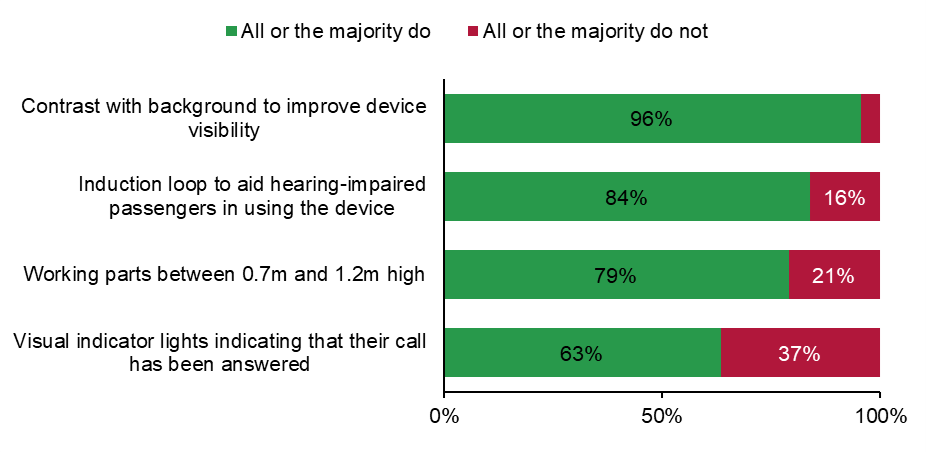There are more than 4,500 help points at over 2,100 mainline railway stations in Great Britain, covering 83% of stations across the rail network. They provide a way for passengers to speak to staff and are commonly located on station platforms or the station concourse
There are 325 unstaffed or partially staffed stations that do not have a help point. For these stations a freephone number is advertised, usually via an information poster at the station, which provides an equivalent service to a help point. We recognise that access to a freephone number is not a suitable alternative for all passengers, particularly those who do not have a mobile phone. The latest figures (from 2020) from the Office for National Statistics indicated that 16% of adults aged 16 and over, 24% of people who identified as having a health condition or illness as defined by the Equality Act, and 47% of people aged 65 and over, did not use a smartphone.
The appearance of help points may vary between stations and different station operators’ networks, often simply because they have been purchased from different suppliers at different times. Newer devices may reflect recent technological innovations.
Based on the data reported by station operators, the majority (86%) of help points are round and have two buttons, for example one for information and one for emergency (as shown in the second image in Figure 1.1). A minority of help points (5%) are digitally interactive and come with touchscreens that allow passengers to browse maps and timetables (as shown in the third image in Figure 1.1).
Figure 1.1 Examples of help points, left to right: Southport (Merseyrail), Cheltenham Spa (Great Western Railway) and Wigan North Western (Avanti West Coast)

Most help points are designed to enable disabled people to use them. However, design variation in help points can also mean accessibility varies.
Data shown in Figure 1.2 is taken from Network Rail’s Station Accessibility Dashboard (further information on the Dashboard is provided later in this section) and shows the design variation in relation to specific accessible features. Most help points have an induction loop to support passengers with a hearing impairment to use them (at 84% of stations with help points, the main help point or majority of help points have an induction loop). However, a smaller proportion of stations’ help points have visual indicator lights to inform passengers that a call is connected (63%).
Figure 1.2 Percentage of stations where the main help point or majority of help points do and do not have specific accessible features

Source: Network Rail’s Station Accessibility Dashboard (accessed 15 October 2024)
Although help point devices may vary across the network, generally passengers can use all types to obtain information, request assistance and report an emergency. These services can also be accessed in a range of other ways. For example, passengers could seek the information they need – the most common usage of help points – from staff where they are available, information screens at stations, station announcements or by using their smartphone to access National Rail or operator websites, apps, and social media platforms.
The regulatory framework
ORR holds operators to account against several complementary requirements in relation to help points that are set out in operator licences, station accessibility standards, and health and safety legislation.
There is no specific regulatory requirement for a station to have a help point, but there are various requirements for services that must be available to passengers that operators can fulfil through the presence of a help point.
Details of all the requirements in relation to help points are listed below.
Licence conditions
There are two inter-related licence obligations relating to the provision of help points. All operators are required, by their operating licences, to establish and comply with an Accessible Travel Policy (ATP) and a Passenger Information Code of Practice.
Accessible Travel Policy: Operators’ ATPs must address the mandatory core requirements of ORR’s ATP Guidance. An ATP sets out, amongst other things, the arrangements and assistance that an operator will provide to protect the interests of disabled people using its services.
The ATP Guidance requires operators to provide passengers with a means of speaking to a human operator that can provide assistance and service information. This may be in-person, via a help point or, where there is sufficient mobile coverage, a freephone number.
Passenger information: All operators have adopted the industry Customer Information Pledges as their regulated Passenger Information Code of Practice. The pledges state that at unstaffed stations, or if no staff are present, there will be a way of getting in touch with the operator and they will inform passengers about this on notices around the station (Pledge E6).
Station accessibility standards
ORR holds operators to account against accessibility standards for stations. These are set out in the Code of Practice on Design Standards for Accessible Railway Stations (Station Code) – mandated by the operator’s licence – and the National Technical Specification Notices that are issued by Government under the Railway (Interoperability) Regulations 2011 and enforceable by ORR under the Health and Safety at Work etc. Act 1974.
As part of station infrastructure works, the standards require operators to provide an alternative information system, such as a help point, if spoken information is not provided via a public address system at a station.
The Station Code also sets out best practice guidelines for ensuring that help point design and installation is accessible, which should be applied whenever a new help point is installed.
Regulation 1371/2007 on rail passengers' rights and obligations (assimilated law)
The regulation on rail passenger rights and obligations, which applies to all operators who hold a station licence, aims to enhance and strengthen the rights of passengers. The regulation sets out minimum levels which are intentionally high-level as they cover international and most domestic services. Article 24: conditions which assistance is provided, provides rights for disabled persons and persons with reduced mobility. It contains the requirement for a designated point or points within or outside a station at which people with reduced mobility or with disabilities can announce their arrival and, if need be, request assistance.
Health and safety
As well as rail-specific legislation, operators must comply with general health and safety legislation. Under the Health and Safety at Work etc. Act 1974, in some cases, operators may determine that help points form a necessary part of managing a safety risk at a station. If standard communication methods are not available, for example the location has insufficient mobile coverage, the visibility of a help point at an unstaffed station can provide a sense of safety and reassurance for passengers if they do not have access to or are unable to use their own mobile device. Likewise, a help point can provide operators with assurance that a passenger will still be able to contact them in case of an emergency.
Scope of the review
We set out to explore whether station operators have systems and processes in place to reliably maintain their help points and reliably answer calls from them, including calls made via freephone numbers to access an equivalent service.
To answer this question, we sought to understand the following areas:
- whether help points and their equivalent freephone number are available for passengers to use at all types of stations across the network
- how help point hardware is tested and maintained
- whether station operators track the performance of their help points and what type of data is monitored and reported on
- how calls made via help points and their equivalent freephone number are managed, where calls get diverted and who answers them
- the impact of the Public Switched Telephone Network (PSTN) switch-off on help points and station operators’ plans for future help point services
Our scope was informed by previous research that we commissioned, which identified potential concerns with the reliability of help point services. For this follow-up review, we did not seek to further explore the passenger experience of using help points, beyond looking at call response times. This means, for example, that we did not look at the accessibility of help point locations or whether the devices themselves are accessible; and we did not visit stations to test help points or check whether a service was provided when arranged through a call made from a help point or freephone number.
We also did not review contracts between station operators and third-party suppliers, where they have contracted out aspects of their help point services, nor assess the costs associated with the upkeep and installation of help points at stations.
Methodology
We engaged with 21 station operators, (including Network Rail) that have one or more help points, and collected data via the following methods:
- Information request: We issued an information request to the 21 station operators. Operators provided quantitative and qualitative data about their help point systems and processes.
- Department for Transport (DfT) Service Quality Regime (SQR): The SQR is a set of standards aimed at improving customer experience. Audits are undertaken at every station at least four times per year across DfT managed operators, assessing a variety of assets including help points and represent a snapshot in time of their performance against specific criteria. DfT shared audit data on help points for 11 operators with ORR.
- Transport Scotland Service Quality Inspection Regime (SQUIRE): Transport Scotland audits the quality of service provided by ScotRail, the station operator for nearly all stations in Scotland, through SQUIRE. All stations are audited every four weeks, including their help points. The results are published by Transport Scotland.
- TfW Rail Service Quality: TfW Rail also undertakes audits of service quality of their help points which assess appearance, functionality and whether the call connects to their control centre. TfW Rail have identified some gaps in their data and are addressing these through their three-year help point strategy. For this reason, we have not included TfW Rail service quality data as part of our review.
- Site visits: We visited two station operators’ sites to understand their approach to help point provision: ScotRail’s contact centre in Paisley to see how calls are answered and processed; West Midlands Trains to explore the rollout of their new help points with Voice over Internet Protocol (VoIP) and artificial intelligence (AI) to assist with passenger queries.
- Meetings with individual station operators: We held meetings with Northern Trains, Southeastern and ScotRail to explore their various approaches to help points and meeting passenger needs.
- Rail Delivery Group’s National Rail Enquiries (NRE) Contact Centre: We worked with the Rail Delivery Group to access call handling data during April 2023 to March 2024, for the ten station operators who at that time used the Contact Centre to answer all their help point calls . The number has since increased to 13.
- Network Rail’s Station Accessibility Dashboard: This dashboard is hosted and maintained by Network Rail. Data is held in Citadel (Network Rail’s asset management database) and station operators are responsible for keeping the data up to date. The raw data is based upon an original dataset collected by DfT between 2021 and 2023 as part of a national accessibility audit programme. We used this data to inform our assessment of the availability and variation of help points across all stations on the rail network. This data was accessed on 15 October 2024.
We also sought feedback on our findings from our Accessible Travel Stakeholder Forum.
This report
The structure of this report is as follows:
- the next chapter sets out our four main findings with a summary of the supporting evidence
- the final chapter sets out recommendations for industry to address our findings and our next steps

